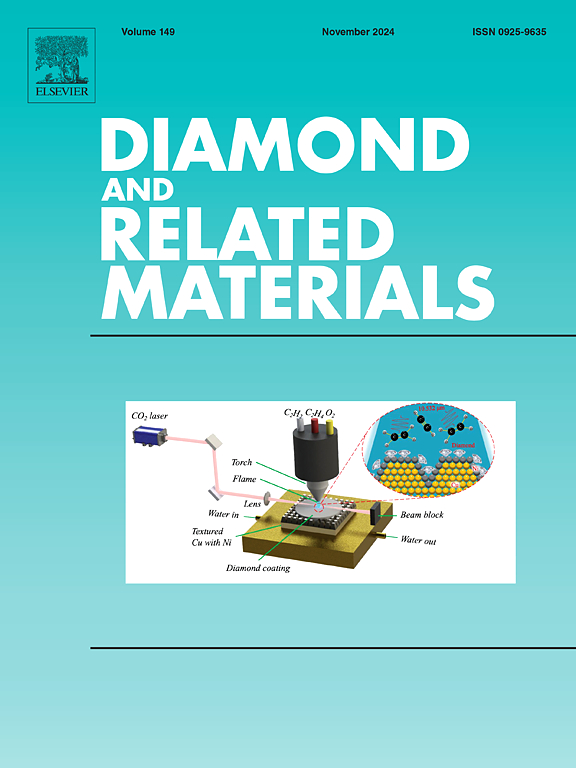Characterization of a carbon nanotube-based X-ray microbeam generation system for low-dose radiobiology
IF 4.3
3区 材料科学
Q2 MATERIALS SCIENCE, COATINGS & FILMS
引用次数: 0
Abstract
We developed a carbon nanotube (CNT)-based field emission system to generate low-dose X-ray microbeams, aimed at radiobiological studies requiring precise dose control. The CNT emitter was directly synthesized on a metal alloy substrate in a radial pattern to enhance field emission performance, achieving a stable emission current of 3 mA at −14 kV in both continuous and pulsed modes. Simulations and experiments confirmed that an emitter-to-window distance of 20 mm provided the highest electron collision efficiency (16.14 %) with minimal scattering. A linear relationship between input power (0.5–70 W) and radiation dose (0.01–3.2 cGy) enabled predictable and adjustable dose delivery. Moreover, the pulsed irradiation capability of the system facilitated temporal modulation through different duty cycles. Cell viability studies (1–10 cGy) revealed distinct responses to continuous versus pulsed exposure, underscoring the potential of the system for investigating adaptive mechanisms and hormesis effects in low-dose radiation biology. This compact, CNT-based X-ray source offers precise spatiotemporal dose control in dual operational modes, opening new opportunities for systematically exploring radiobiological phenomena under low-dose conditions.

基于碳纳米管的低剂量放射生物学x射线微束产生系统的表征
我们开发了一种基于碳纳米管(CNT)的场发射系统来产生低剂量的x射线微光束,针对需要精确剂量控制的放射生物学研究。在金属合金衬底上直接以径向方式合成CNT发射极,提高了场发射性能,在连续和脉冲模式下均实现了- 14 kV下3 mA的稳定发射电流。仿真和实验证实,当发射窗距离为20 mm时,电子碰撞效率最高(16.14%),散射最小。输入功率(0.5 - 70w)和辐射剂量(0.01-3.2 cGy)之间的线性关系使剂量传递可预测和可调节。此外,该系统的脉冲辐照能力有助于通过不同占空比进行时间调制。细胞活力研究(1-10 cGy)揭示了连续照射和脉冲照射的不同反应,强调了该系统在研究低剂量辐射生物学中的适应机制和激效效应方面的潜力。这种紧凑的、基于碳纳米管的x射线源在双重操作模式下提供精确的时空剂量控制,为系统地探索低剂量条件下的放射生物学现象开辟了新的机会。
本文章由计算机程序翻译,如有差异,请以英文原文为准。
求助全文
约1分钟内获得全文
求助全文
来源期刊

Diamond and Related Materials
工程技术-材料科学:综合
CiteScore
6.00
自引率
14.60%
发文量
702
审稿时长
2.1 months
期刊介绍:
DRM is a leading international journal that publishes new fundamental and applied research on all forms of diamond, the integration of diamond with other advanced materials and development of technologies exploiting diamond. The synthesis, characterization and processing of single crystal diamond, polycrystalline films, nanodiamond powders and heterostructures with other advanced materials are encouraged topics for technical and review articles. In addition to diamond, the journal publishes manuscripts on the synthesis, characterization and application of other related materials including diamond-like carbons, carbon nanotubes, graphene, and boron and carbon nitrides. Articles are sought on the chemical functionalization of diamond and related materials as well as their use in electrochemistry, energy storage and conversion, chemical and biological sensing, imaging, thermal management, photonic and quantum applications, electron emission and electronic devices.
The International Conference on Diamond and Carbon Materials has evolved into the largest and most well attended forum in the field of diamond, providing a forum to showcase the latest results in the science and technology of diamond and other carbon materials such as carbon nanotubes, graphene, and diamond-like carbon. Run annually in association with Diamond and Related Materials the conference provides junior and established researchers the opportunity to exchange the latest results ranging from fundamental physical and chemical concepts to applied research focusing on the next generation carbon-based devices.
 求助内容:
求助内容: 应助结果提醒方式:
应助结果提醒方式:


